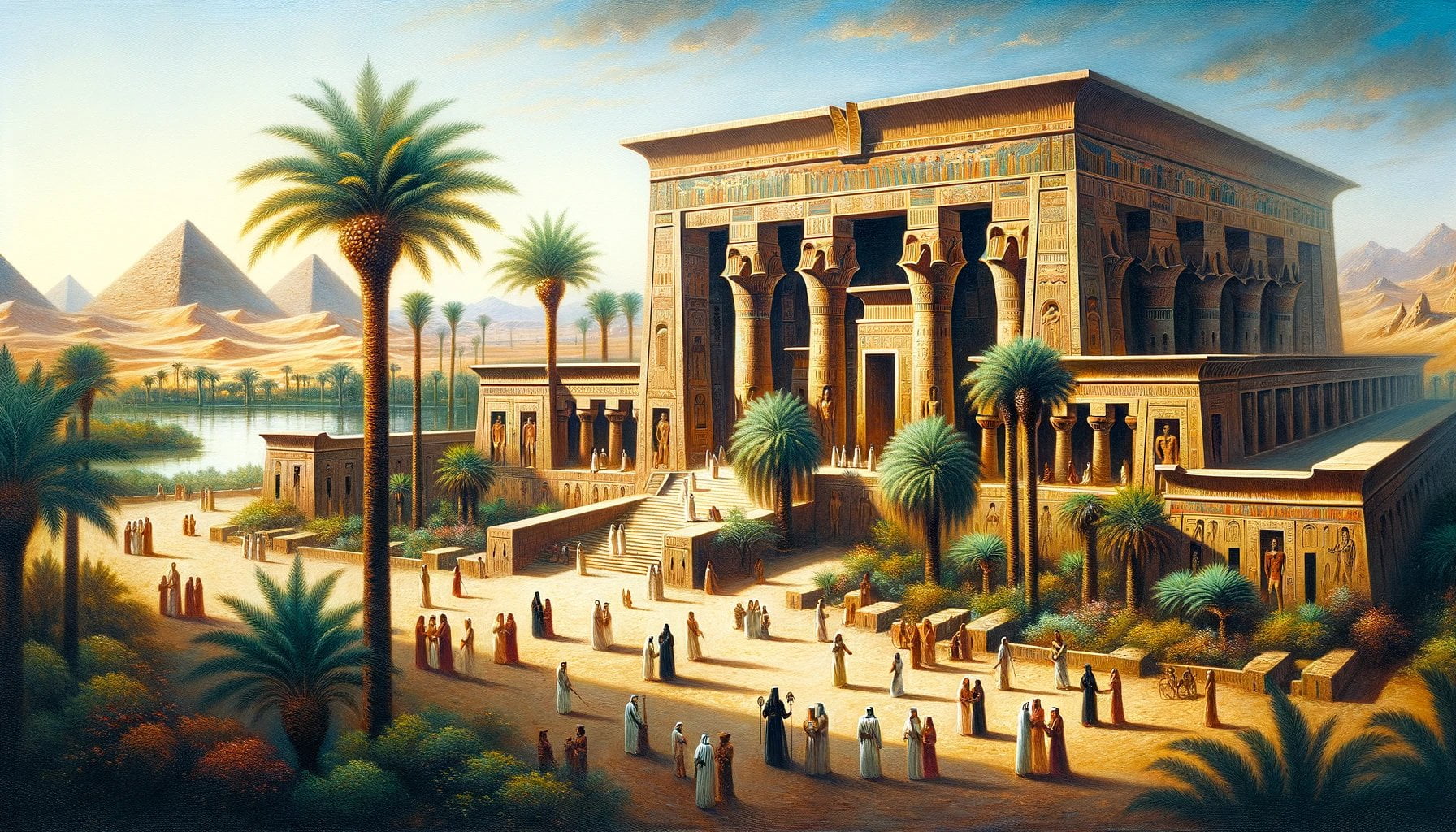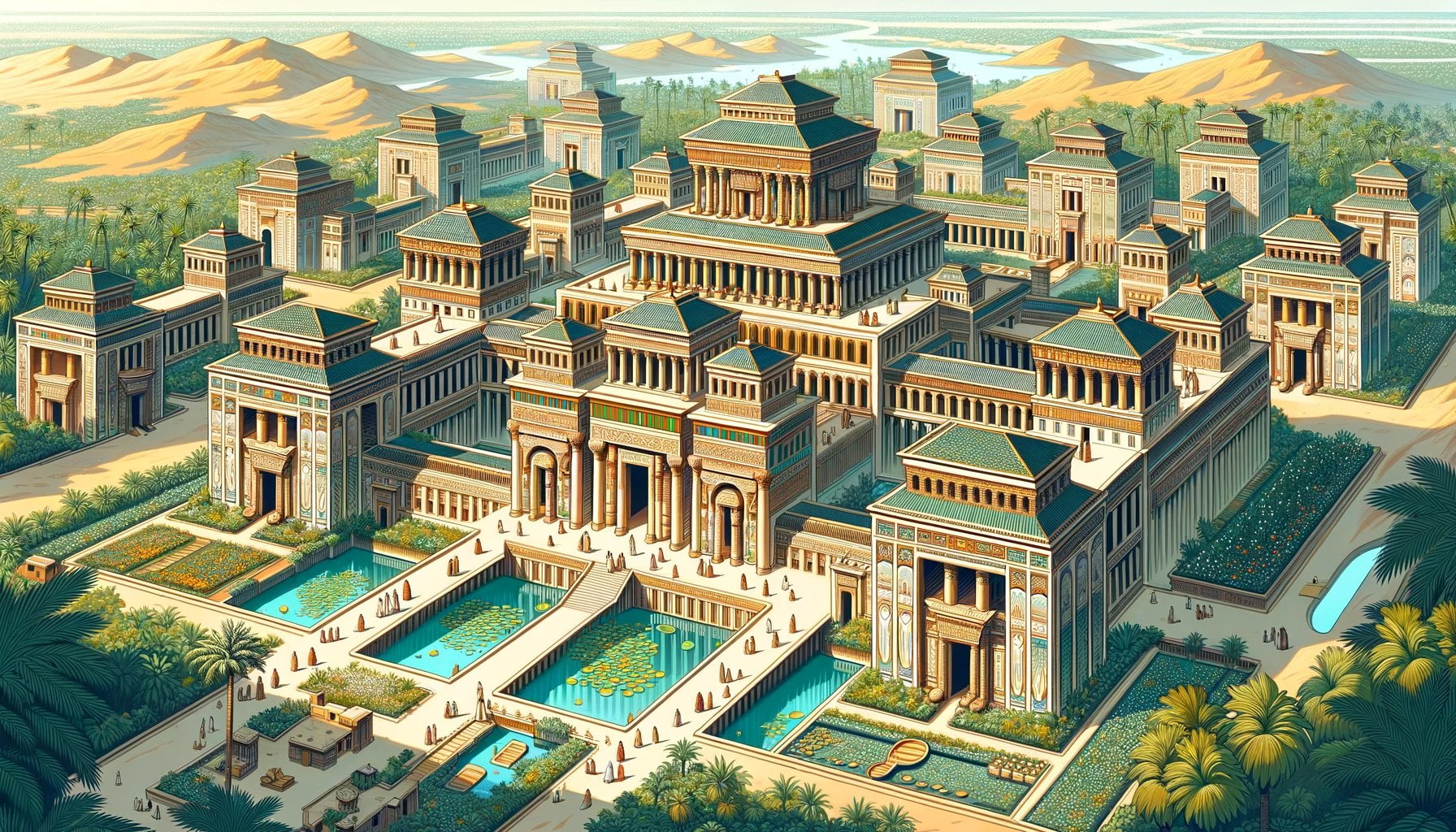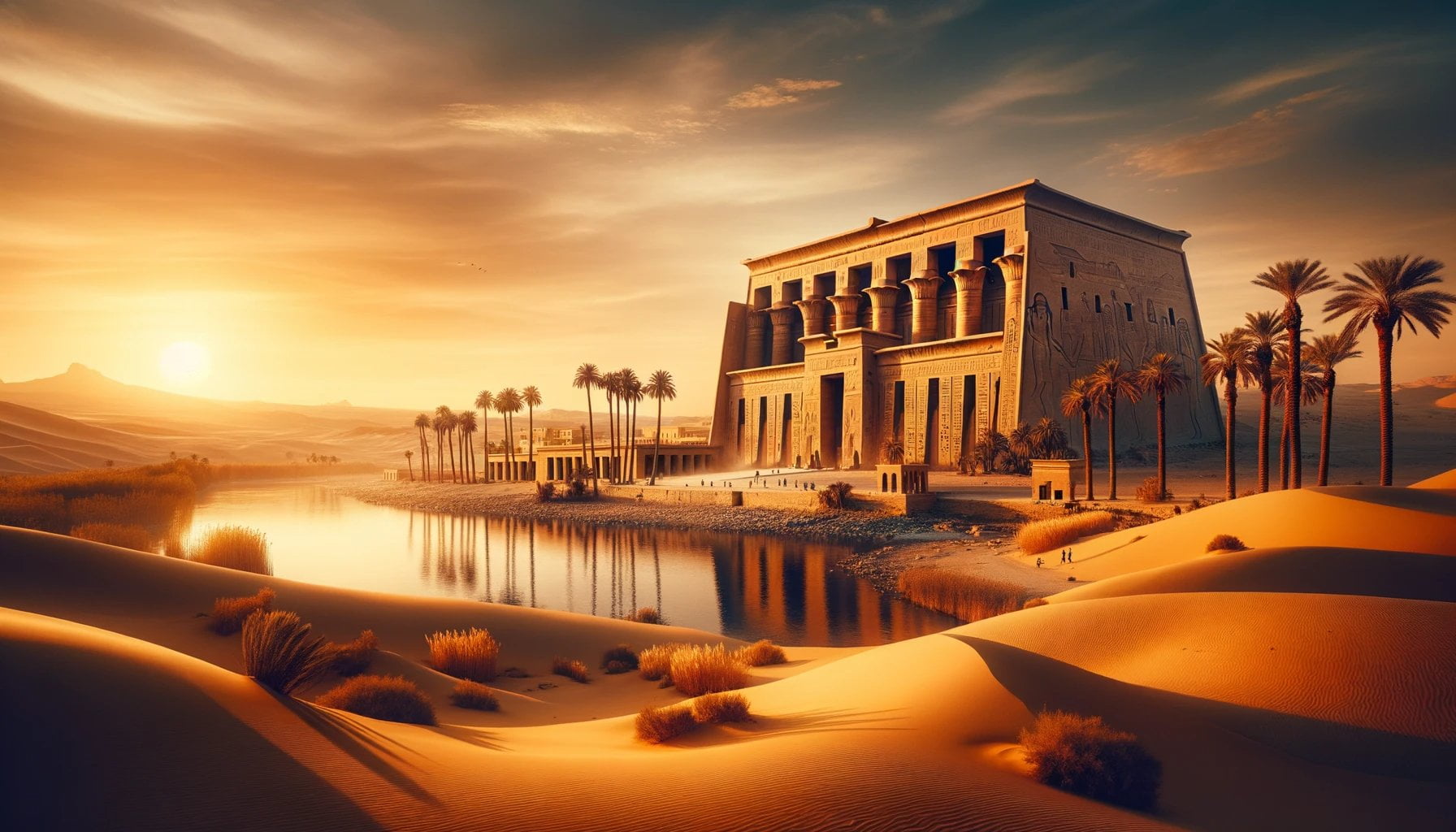Unveiling the secrets of Ancient Egypt’s grand palaces is like embarking on a thrilling adventure through the annals of history. Picture yourself transported to a time of pharaohs and gleaming palaces that served as both opulent homes and nerve centers of a mighty civilization. With each page of this captivating journey, you’ll uncover the intricate designs, lavish decorations, and intriguing stories behind these architectural marvels that shaped the course of ancient Egypt.

Palaces in Ancient Egypt
Imagine Ancient Egypt, a land of pharaohs, pyramids, and, yes, palaces! But these weren’t just any old fancy houses. We’re talking sprawling complexes, bustling with activity – royal residences, government headquarters, sacred temples, and even workshops, all rolled into one.
These palaces were the epicenter of power, the beating heart of the nation. Officials bustled through courtyards, priests performed rituals in grand temples, and artisans crafted exquisite goods, all within the palace walls. It was a hive of activity that showcased the might and majesty of the pharaoh.
Why such massive complexes? In ancient Egypt, pharaohs weren’t just kings; they were considered living gods! Their palaces reflected this divine status, serving as awe-inspiring symbols of their power and authority.
Location was key. Ancient Egyptians strategically constructed these grandiose palaces along the Nile River, their lifeline. This provided easy access to water and transformed these palaces into bustling ports, connecting the empire’s farthest corners and allowing the pharaoh to keep their finger on the pulse of the nation.
And the architecture was simply breathtaking. Towering columns reached for the sky, walls adorned with intricate carvings told stories, and dazzling decorations shimmered with gold and precious stones. Every detail, from the astronomical alignments to the mathematical precision, whispered of the ingenuity of the ancient Egyptian architects and artisans.
To sum it up, palaces in ancient Egypt were more than just royal residences. They were symbols of power, expressions of artistic brilliance, and vibrant hubs of activity that kept the wheels of this ancient civilization turning.
- Did you know that the Battle of Actium was the largest naval battle in ancient history? Check out more about it here!
- Looking for fascinating ancient dog epitaphs? Look no further, we have a collection of them here!
- Explore the mysteries of an ancient city in Peru and discover its rich history here!
- Dive into the remarkable stories of ancient Vietnamese warriors and their incredible feats here!
- Curious about the intriguing names of ancient Egyptian queens? Uncover their secrets here!
- Discover the mesmerizing ancient Syrian names that are steeped in history here!
- Discover the hidden stories behind ancient queen names that ruled with power and grace here!
- Uncover the ingenious ancient Persian inventions that revolutionized history here!
- Embark on a journey through time and explore the remarkable achievements of ancient Romans here!
- Delve into the wonders of ancient castles in Africa and marvel at their grandeur here!
- Step into the mythical world of ancient Greek castles and immerse yourself in their legendary tales here!
- Immerse yourself in the rich history of an ancient Italian city that has stood the test of time here!

Unveiling the Majesty: Architectural Wonders of Egyptian Palaces
Stepping inside an Egyptian palace was like stepping into a whole different world. Imagine a seamless blend of grand Islamic architecture with elegant European touches – that was the magic Egyptian palaces possessed. These weren’t just buildings; they were powerful statements, showcasing the wealth and influence of ancient Egypt. Think giant columns reaching for the sky, walls covered in intricate carvings that told stories, and decorations so rich and detailed they’d take your breath away.
Ever wondered why many palaces sprung up along the Nile? It wasn’t just for the beautiful view. The Nile was a lifeline, a bustling trade route that kept things moving. Building close by meant easy access to water and all the goodies coming in from far-off lands.
But these palaces were much more than just pretty faces. They were like the beating heart of Egypt, serving many purposes. Imagine them as grand stages where the pharaohs, considered almost god-like, would showcase their power and rule. These palaces hummed with activity – important officials rushing through corridors, courtiers whispering secrets, and servants diligently tending to every need. This was the nerve center of the empire, where decisions were made and laws were passed.
And the art! Paintings bursting with color, sculptures that seemed to breathe life into stone, and jewelry so exquisite it could rival the stars – these palaces housed some of ancient Egypt’s most precious treasures.
Even today, these palaces continue to amaze us. They’re like giant history books, their walls whispering tales of ancient traditions, beliefs, and the day-to-day lives of the people who lived and worked within them. They stand as a testament to the incredible skills of the architects, engineers, and artisans who, with their bare hands, created structures that have stood the test of time.
The architectural innovations and sheer brilliance showcased in these palaces continue to inspire architects and historians even now. Egyptian palaces weren’t just homes; they were symbols of power, centers of art and culture, and a lasting legacy of the ingenuity and creativity of a civilization that thrived thousands of years ago.
Key Points:
- Egyptian palaces showcase a fusion of Islamic and European architectural styles, reflecting a blend of cultural influences.
- The design and construction of Egyptian royal residences embody the grandeur and opulence of ancient Egyptian civilization.
- Exploring Egyptian palaces offers a glimpse into the opulent lifestyles and architectural advancements of ancient Egypt’s rulers.
- Understanding Egyptian palace architecture provides insights into the cultural values and aspirations of ancient Egyptian society.
Life Inside the Palace Walls: Administration, Economy, and Daily Life
Imagine stepping through the towering gates of an ancient Egyptian palace. You’d find yourself not just in a luxurious home, but in the beating heart of the kingdom! These palaces weren’t merely places where pharaohs relaxed in splendor; they were bustling centers of power, commerce, and everyday life.
Think of the palace as the “control room” of ancient Egypt. High-ranking officials, the pharaoh’s most trusted advisors, worked tirelessly within its walls, ensuring the smooth running of this vast civilization. They made sure taxes were collected, laws were upheld, and resources were distributed fairly, keeping the wheels of government turning.
But the palace wasn’t all about politics and administration. It was also an economic powerhouse! Imagine enormous storehouses overflowing with grain, precious metals, and exotic goods, all carefully managed by skilled scribes and overseers. Bustling markets, held within the palace complex or just outside its gates, attracted merchants and traders from far and wide, bringing in even more wealth and forging vital trade links.
Of course, let’s not forget about the residents! The pharaoh and their family lived a life of luxury within the palace, surrounded by servants catering to their every whim. But beyond the opulence and grandeur, daily life in the palace was a hive of activity. Elaborate rituals and ceremonies were performed regularly, solidifying the pharaoh’s divine status and connection to the gods. Skilled artisans crafted exquisite jewelry and artwork, musicians filled the air with music, and gardens provided tranquil spaces for reflection.
Life inside the palace walls was a unique blend of power, commerce, and everyday activity. It was a microcosm of Egyptian society, where the mundane and the magnificent intertwined.
Key Lines:
- Royal palaces in ancient Egypt were multifaceted structures serving as administrative centers, economic hubs, and symbols of political power.
- The palaces featured complex visual programs in their architecture, including paintings that conveyed royal authority and divine connections.
- The architectural design of palaces diversified over time, reflecting changes in royal power dynamics and the adoption of foreign influences.
- The study of royal palaces provides insights into the socio-political and cultural aspects of ancient Egyptian society.
The Evolution of Palace Architecture: From Old Kingdom to New Kingdom
We’ve talked about how important palaces were in ancient Egypt, so let’s dive a little deeper into how their designs changed over time. It’s actually pretty fascinating to see how these changes mirrored what was happening in Egyptian society as a whole.
Think about the Old Kingdom, a time when the pharaoh’s power was totally centralized. Their palaces reflected that – straightforward, rectangular buildings with a central courtyard and spaces for official business. It was all about showcasing order and control.
Then came the Middle Kingdom, and things began to shift. Pharaohs were still powerful, but the royal court started to gain more influence. You can see this reflected in the palaces, which got bigger and more elaborate. Throne rooms and audience halls popped up, places where the pharaoh could interact with the growing court and emphasize their royal status.
But the real showstopper was the New Kingdom. Palaces from this period were on a whole other level – massive complexes with numerous courtyards, temples woven into the design, and lavish gardens. These palaces were basically shouting the wealth and power of the New Kingdom pharaohs, who saw themselves as a direct link between the gods and everyday people.
Think about it:
- Palaces were multi-purpose: They were homes for royalty, centers of government, and powerful symbols of the pharaoh’s authority.
- Architectural styles were always evolving: What started as simple structures gradually transformed into vast, intricate complexes.
- Architecture mirrored beliefs: Changes in political structures and religious ideas were directly reflected in how palaces were designed.
- Palaces are time capsules: Studying them gives us incredible insights into ancient Egyptian culture, daily life, and the incredible artistry of the time.
KEY LINES:
- Ancient Egyptian architecture encompasses distinct styles spanning millennia, showcasing funerary, religious, and palatial structures reflecting evolving beliefs and societal norms.
- Palaces served not only as royal residences but also as microcosms of the divinely created universe, symbolizing the king’s authority and connection to the gods.
- Royal palaces underwent architectural transformations over time, reflecting changes in political power and religious ideologies.
- Understanding the intricate designs and symbolism of Ancient Egyptian architecture offers insights into the civilization’s cultural, spiritual, and political landscape.
















